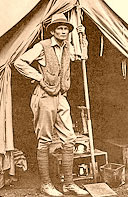|
Hiram Bingham, the American explorer who found the
ruins of Machu Picchu in 1911, wrote:
No one knows the
origin of the people over whom the Incas
rules. Physical anthropologists assure that
the bony structure of the American Indian is
closely related to that of the people of
Northeast Siberia. However, that does not
prove that the migration went from Asia to
America any more than it proves the people
of Eastern Asia came from America. Whenever
that migration took place, and in whichever
direction, it happened so many thousands of
years ago that archaeological evidence, as
distinct from anthropological, is lacking.
In other words, there appears to be no
resemblance between the culture of
Northeastern Asia and Central South America.
Furthermore, since wheat, one of the most
valuable crops on the world, was developed
in Asia and was unknown in America, and
since similar ignorance prevailed in Asia
regarding two other enormously important
crops, potatoes and maize, it appears fairly
certain that the migration took place many
thousands of year ago. This appears to be
borne out by the recent discovery in North
America of the remains of glacial man whose
age is estimated to be about 20,000 years.
The Incas took such trouble to spread the
Quechua language wherever they went that it is fair to assume that they
descended from a Quechua tribe. The Quechuas are brown in color. Their
hair is straight and black. Gray hair is seldom seen. It is still the
custom among the men in certain localities to wear their hair long and
braided. Beards are very rare and when they occur are extremely sparse.
Bearded Indians are almost certain to give signs of traces of Spanish
blood.
Among the Quechuas, bald heads are very
rare. Teeth seem to be more enduring than with us. Throughout the Andes
the frequency of well-preserved teeth is noteworthy, except on sugar
plantations where there is opportunity to indulge freely in crude brown
sugar nibbled form cakes or mixed with parched corn and eaten as a
convenient ration. Since the Incas did not know how to make sugar, it is
fair to assume that they had good teeth and were not troubled by having
to chew the hard kernels of their favorite parched corn.
The Quechua face is broad and short.
Freckles are not common, although a large proportion of the mountain
Indians are pock-marked. Asiatic smallpox was probably not known in the
Andes in prehistoric times. On the other hand, there is abundant
evidence, both in prehistoric tombs and in the vivid records of coastal
pottery, that syphilis did not come from the Old World, but was an
aboriginal disease. In fact, it was probably taken from America to the
Mediterranean by the sailors of the early discoverers and explorers. It
was the worst gift the New World gave to the Old World in exchange for
the "benefits" of European culture.
There is no evidence that the Incas were
fat. One hardly ever sees a fat mountain Indian today. It is difficult
to tell whether this is a racial characteristic or due to the necessity
of hard exercise in the mountains. Certainly the abundant use of white
potatoes is supposed to be fattening. The diet of the Incas did not
contain much meat since both llamas and alpacas were too useful to be
used as food except in the case of animals that died of old age.
Although the Peruvian highlander made the
best use he could of the llama, he was never able to develop its slender
legs and weak back sufficiently to use it for loads weighing more than
one hundred pounds. Consequently, for the carrying of heavy burdens he
has had to depend on himself. As a result it is not surprising that
while his arms are poorly developed his shoulders are broader, his back
muscles stronger and the calves of his legs, larger and more powerful
than those of almost any other race.
Source:
‘Lost City of the Incas, The Story of Machu
Picchu and its Builders’ by Hiram Bingham
The American explorer who found the ruins of Machu Picchu in 1911.

Hiram Bingham at Machu Picchu
The inspiration for Indiana Jones?
|